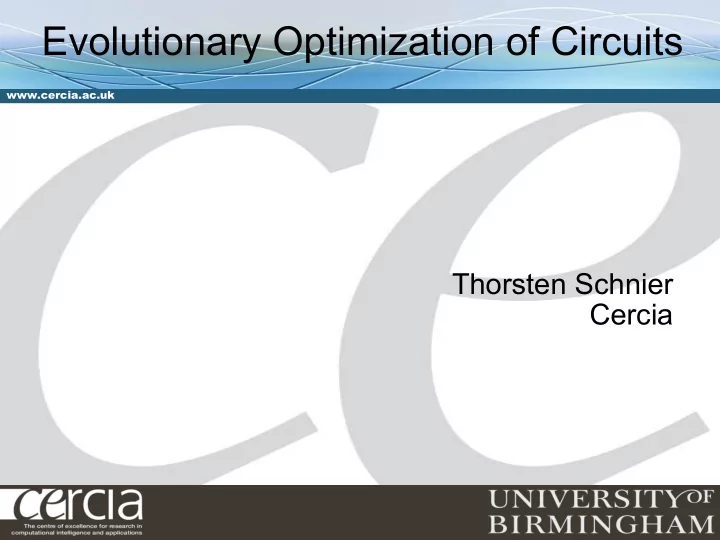

Evolutionary Optimization of Circuits www.cercia.ac.uk Thorsten Schnier Cercia
A cheery quote to start... www.cercia.ac.uk “ The future for EH-based digital circuit synthesis methods looks bleak. The truth is EH-based approaches simply can’t stand up to existing design methods. Evolving combinational and sequential circuitry is never going to intrigue anyone... Consequently it is strongly recommended that EH practitioners abandon any further work on evolving combinational or sequential circuits ” Garrison W. Greenwood, WEAH '09 (Editor-in-Chief of IEEE TEC)
What's Evolvable Hardware (EH)? www.cercia.ac.uk ● Design of hardware by means of evolutionary computation ● Analog circuits – Amplifier, filters, oscillators,... ● Digital circuits – Sequential, combinatorial ● 'Lower-level' – Geometries, routing, placement, materials,... ● 'Weird stuff' – In-materio evolution
What is Evolutionary Computation ? www.cercia.ac.uk ● Population based, stochastic search algorithm ● Intelligent way to do trial-and-error ● Survival of the fittest ● Crossover and mutation
Success in Design Optimization www.cercia.ac.uk ● Many human-competitive solutions ● Many patented results ● Example: turbine blade design (Honda):
Evolving Digital Circuits www.cercia.ac.uk ● Representation example: Cartesian GP
Evolving Digital Circuits www.cercia.ac.uk ● Representation example: Cartesian GP 1 5 9 13 2 14 6 10 3 7 11 15 4 8 16 12
Fitness Evaluation www.cercia.ac.uk ● Digital circuits in simulation: – Just try all possible inputs – Count how many output bits are wrong ● (you can do that in parallel) – Mostly sequential logic only – Millions and 100s of Millions of evaluations.... ● Or: on the real hardware
What can you do with it? www.cercia.ac.uk ● Evolve 4x4 bit multipliers ● Machine learning – Compression engines – Classifiers ● Evolve Signal Processors – Digital filters (e.g. for low coefficient sensitivity) – Linear transforms
What's Wrong? www.cercia.ac.uk ● According to Greenwood – EAs can't handle different levels of abstraction – EAs can't use pre-designed IP – EAs can't instantiate on-chip resources – EAs don't handle design constraints effectively – Scalability
Should I give up ? www.cercia.ac.uk ● No way ! – Get better – Find niches where the competition is even worse...
Better Fitness www.cercia.ac.uk ● No fitness gradient – integer fitness – Deadly for EA performance – Neutral walk crucial – Is it even accurate? ● Can we get additional information ? – Are we getting closer to a correct circuit? – Internal states useful? ● Pseudo-Quantum gates ? – A little bit of 'or', a little bit of 'and'...
Better Operators www.cercia.ac.uk ● Crossover pretty much useless – Can we define an intelligent crossover? ● Mutation completely random – Likely to destroy useful structures – Can we define a better mutation? ● Functionally-neutral mutations for optimization ● Bias towards local connections helps sometimes
Simplify the Problem www.cercia.ac.uk ● Divide and Conquer – By outputs – By input – Much faster to evolve four 4-input circuits than one 6-input circuit
Growth www.cercia.ac.uk ● Discovery of modularity – A human would assemble a multi-input adder from half-adders – An EA usually wouldn't – We can push EA to do this by including 'development' in the representation, and evaluating for more and more inputs
Incorporate Knowledge www.cercia.ac.uk ● Multi-Level design, design using IP – Is there an optimization problem at higher levels? – Is there a fitness that I can use at higher levels?
Find Niches www.cercia.ac.uk ● EvoComp is most competitive where there is no perfect conventional way of doing things – Approximations are used – Only part of the design space are used – There is room for improvement – Your designers require a cauldron, and a daily ration of chicken feet...
Optimization www.cercia.ac.uk ● The smallest known instances of (simple) adders and multipliers have been generated using EH ● Multi-Objective problems – Exploration of tradeoff fronts (e.g. digital filters) ● Post human-design optimization
Fault-Tolerance www.cercia.ac.uk ● Redundancy relies on diversity ● Is there a conventional design methodology for diversity? – EH can deliver diversity – EH can even deliver optimized diversity
Evolved Circuit-pairs www.cercia.ac.uk
Unusual hardware www.cercia.ac.uk ● Adrian Thompson's frequency-discriminator-on- a-FPGA ● 'In-materio' evolution – e.g. using LCD, wetware,... ● Ternary logic? ● Quantum logic?
Repair and Callibration www.cercia.ac.uk ● Incomplete knowledge – Solar Storm - Space radiation damaged FPGA – can you repair it without knowing the exact faults? – Production has tolerances – can you calibrate each chip to increase yields (analog) ?
EA on massively parallel hardware www.cercia.ac.uk ● Evolutionary algorithms parallelize easily – Fitness evaluation in parallel – Island models with migration ● Potential for implementation on FPGA (done), GPU, Physics engines, … ● Depends on application/fitness function
Summary www.cercia.ac.uk ● Not a general replacement for traditional design techniques ● Potential for use in combination with traditional design tools ● Currently best for 'unusual' applications ● Room for improvement
Recommend
More recommend